Healthcare Law and Legislation: Domestic Violence Protocol
VerifiedAdded on 2022/12/29
|10
|2286
|97
AI Summary
This document discusses the development and administration of a comprehensive domestic violence protocol in healthcare settings. It covers the assessment, documentation, mandated reporting, care continuity, and support services provided to patients who are victims of domestic violence. The protocol aims to ensure prompt detection, reporting, and delivery of justice and treatment for victims, with the goal of achieving positive physiological and psychological health outcomes.
Contribute Materials
Your contribution can guide someone’s learning journey. Share your
documents today.

Running head: HEALTHCARE LAW AND LEGISLATION
HEALTHCARE LAW AND LEGISLATION: DOMESTIC VIOLENCE PROTOCOL
Name of the Student:
Name of the University:
Author note:
HEALTHCARE LAW AND LEGISLATION: DOMESTIC VIOLENCE PROTOCOL
Name of the Student:
Name of the University:
Author note:
Secure Best Marks with AI Grader
Need help grading? Try our AI Grader for instant feedback on your assignments.
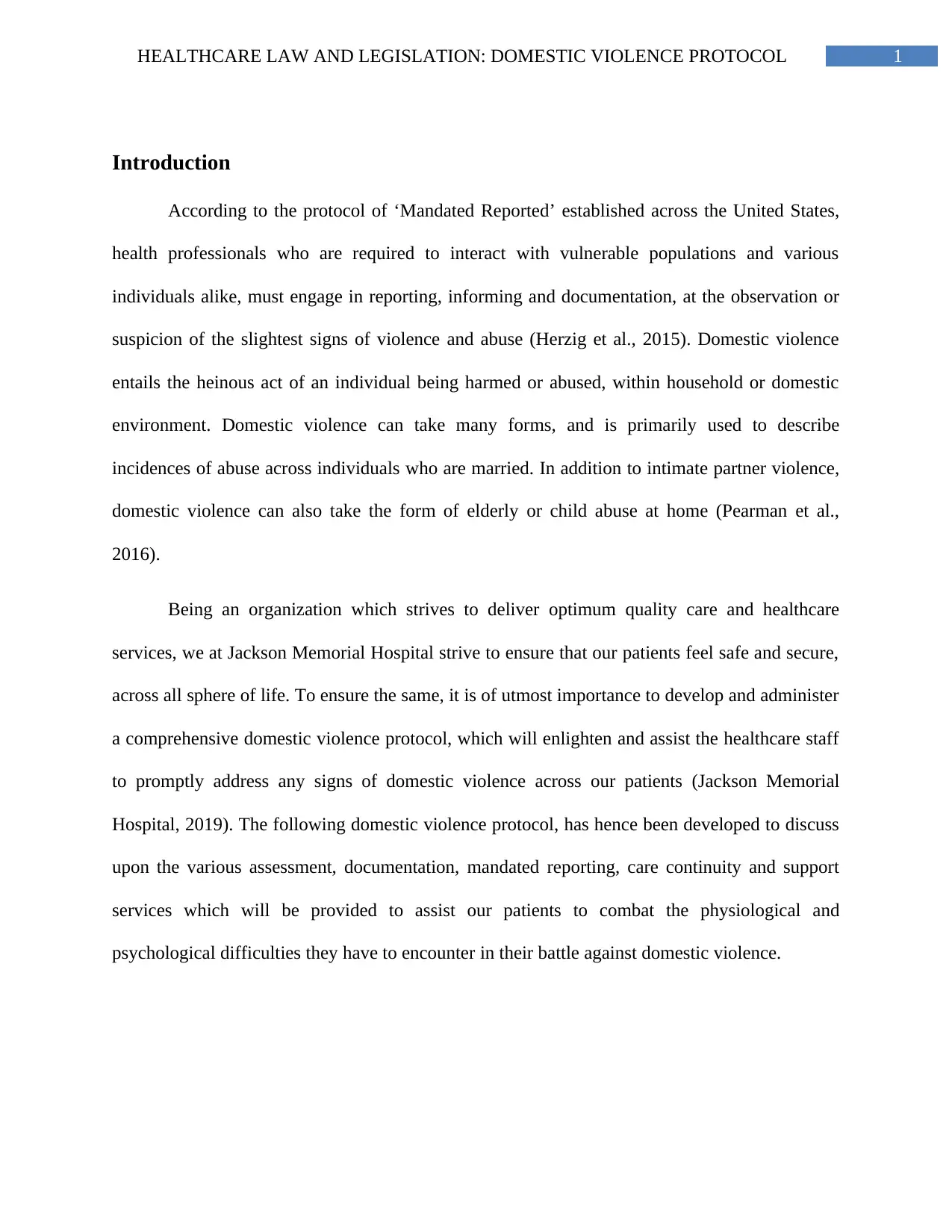
1HEALTHCARE LAW AND LEGISLATION: DOMESTIC VIOLENCE PROTOCOL
Introduction
According to the protocol of ‘Mandated Reported’ established across the United States,
health professionals who are required to interact with vulnerable populations and various
individuals alike, must engage in reporting, informing and documentation, at the observation or
suspicion of the slightest signs of violence and abuse (Herzig et al., 2015). Domestic violence
entails the heinous act of an individual being harmed or abused, within household or domestic
environment. Domestic violence can take many forms, and is primarily used to describe
incidences of abuse across individuals who are married. In addition to intimate partner violence,
domestic violence can also take the form of elderly or child abuse at home (Pearman et al.,
2016).
Being an organization which strives to deliver optimum quality care and healthcare
services, we at Jackson Memorial Hospital strive to ensure that our patients feel safe and secure,
across all sphere of life. To ensure the same, it is of utmost importance to develop and administer
a comprehensive domestic violence protocol, which will enlighten and assist the healthcare staff
to promptly address any signs of domestic violence across our patients (Jackson Memorial
Hospital, 2019). The following domestic violence protocol, has hence been developed to discuss
upon the various assessment, documentation, mandated reporting, care continuity and support
services which will be provided to assist our patients to combat the physiological and
psychological difficulties they have to encounter in their battle against domestic violence.
Introduction
According to the protocol of ‘Mandated Reported’ established across the United States,
health professionals who are required to interact with vulnerable populations and various
individuals alike, must engage in reporting, informing and documentation, at the observation or
suspicion of the slightest signs of violence and abuse (Herzig et al., 2015). Domestic violence
entails the heinous act of an individual being harmed or abused, within household or domestic
environment. Domestic violence can take many forms, and is primarily used to describe
incidences of abuse across individuals who are married. In addition to intimate partner violence,
domestic violence can also take the form of elderly or child abuse at home (Pearman et al.,
2016).
Being an organization which strives to deliver optimum quality care and healthcare
services, we at Jackson Memorial Hospital strive to ensure that our patients feel safe and secure,
across all sphere of life. To ensure the same, it is of utmost importance to develop and administer
a comprehensive domestic violence protocol, which will enlighten and assist the healthcare staff
to promptly address any signs of domestic violence across our patients (Jackson Memorial
Hospital, 2019). The following domestic violence protocol, has hence been developed to discuss
upon the various assessment, documentation, mandated reporting, care continuity and support
services which will be provided to assist our patients to combat the physiological and
psychological difficulties they have to encounter in their battle against domestic violence.

2HEALTHCARE LAW AND LEGISLATION: DOMESTIC VIOLENCE PROTOCOL
Domestic Violence Protocol
Presentation Page
1. Project Name: ‘Speak Up’ – an organizational protocol and initiative by Jackson
Memorial Hospital to assist patients inflicted with injuries and abuse associated with
domestic violence.
2. Organization Name: Jackson Memorial Hospital
3. Business Address: 1611 N.W. 12th Avenue
4. City, ST, Zip: Miami, FL 33136
5. Telephone Number: 305-585-1111
6. Facsimile Number: 305-585-1412
7. Website Address: https://jacksonhealth.org/
8. Email Address: info@jhsmiami.org
Definition and Guiding Principle
Definition of Domestic Violence: Domestic violence, also known otherwise of family
violence or domestic abuse, can be defined as the act of abuse or violence by an individual
against another individual, conducted typically across household or domestic environments or
among individuals residing in cohabitation (McTavish et al., 2016). When administered by a
spouse or an individual in an intimate relationship with another, it is also known as intimate
partner violence and can occur in relationships which are both homosexual as well as
heterosexual and even among partners who are now separate or formerly married to each other.
Violence directed at elderly residents or children residing in the household by parents, adults,
guardians or caretakers can also be considered as domestic violence in the form of elderly or
Domestic Violence Protocol
Presentation Page
1. Project Name: ‘Speak Up’ – an organizational protocol and initiative by Jackson
Memorial Hospital to assist patients inflicted with injuries and abuse associated with
domestic violence.
2. Organization Name: Jackson Memorial Hospital
3. Business Address: 1611 N.W. 12th Avenue
4. City, ST, Zip: Miami, FL 33136
5. Telephone Number: 305-585-1111
6. Facsimile Number: 305-585-1412
7. Website Address: https://jacksonhealth.org/
8. Email Address: info@jhsmiami.org
Definition and Guiding Principle
Definition of Domestic Violence: Domestic violence, also known otherwise of family
violence or domestic abuse, can be defined as the act of abuse or violence by an individual
against another individual, conducted typically across household or domestic environments or
among individuals residing in cohabitation (McTavish et al., 2016). When administered by a
spouse or an individual in an intimate relationship with another, it is also known as intimate
partner violence and can occur in relationships which are both homosexual as well as
heterosexual and even among partners who are now separate or formerly married to each other.
Violence directed at elderly residents or children residing in the household by parents, adults,
guardians or caretakers can also be considered as domestic violence in the form of elderly or
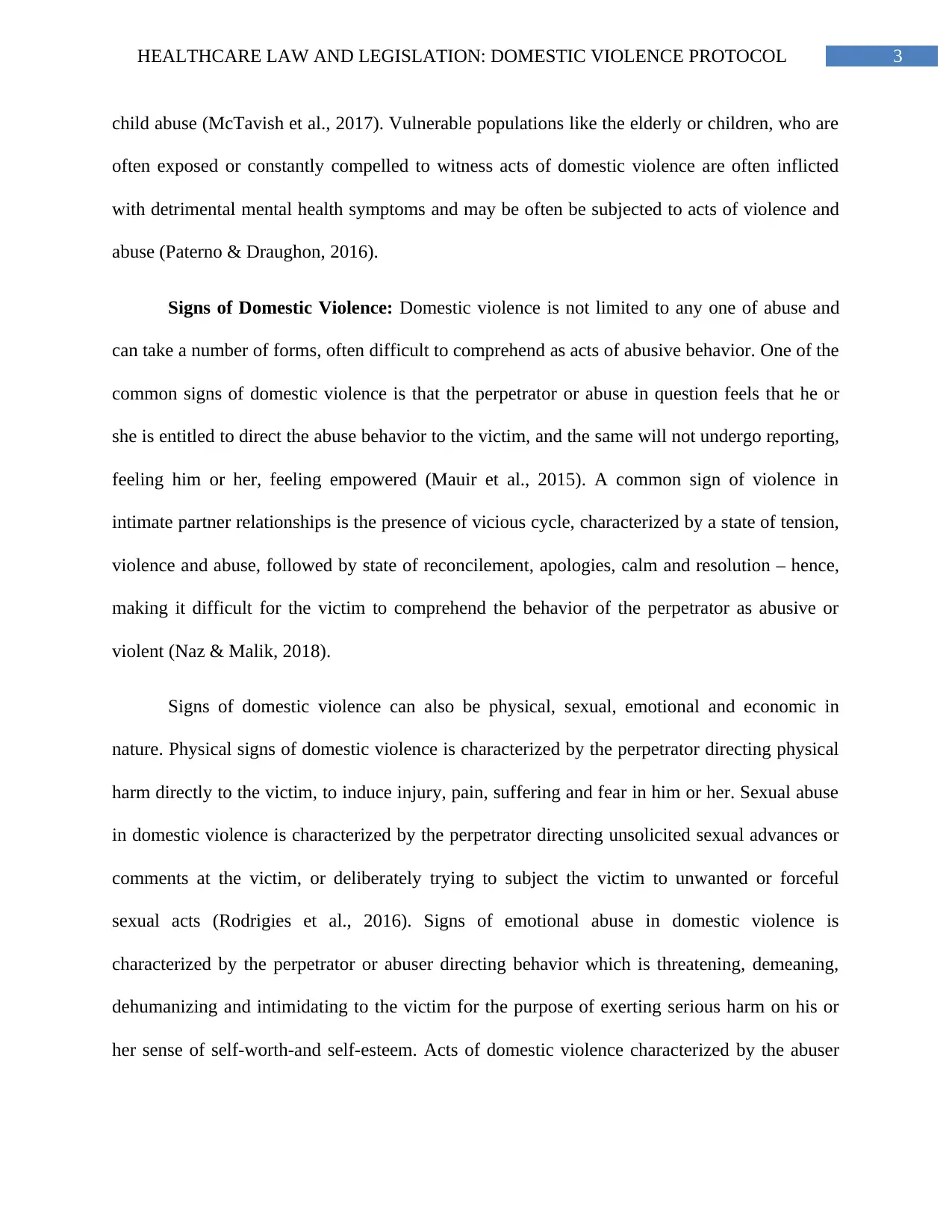
3HEALTHCARE LAW AND LEGISLATION: DOMESTIC VIOLENCE PROTOCOL
child abuse (McTavish et al., 2017). Vulnerable populations like the elderly or children, who are
often exposed or constantly compelled to witness acts of domestic violence are often inflicted
with detrimental mental health symptoms and may be often be subjected to acts of violence and
abuse (Paterno & Draughon, 2016).
Signs of Domestic Violence: Domestic violence is not limited to any one of abuse and
can take a number of forms, often difficult to comprehend as acts of abusive behavior. One of the
common signs of domestic violence is that the perpetrator or abuse in question feels that he or
she is entitled to direct the abuse behavior to the victim, and the same will not undergo reporting,
feeling him or her, feeling empowered (Mauir et al., 2015). A common sign of violence in
intimate partner relationships is the presence of vicious cycle, characterized by a state of tension,
violence and abuse, followed by state of reconcilement, apologies, calm and resolution – hence,
making it difficult for the victim to comprehend the behavior of the perpetrator as abusive or
violent (Naz & Malik, 2018).
Signs of domestic violence can also be physical, sexual, emotional and economic in
nature. Physical signs of domestic violence is characterized by the perpetrator directing physical
harm directly to the victim, to induce injury, pain, suffering and fear in him or her. Sexual abuse
in domestic violence is characterized by the perpetrator directing unsolicited sexual advances or
comments at the victim, or deliberately trying to subject the victim to unwanted or forceful
sexual acts (Rodrigies et al., 2016). Signs of emotional abuse in domestic violence is
characterized by the perpetrator or abuser directing behavior which is threatening, demeaning,
dehumanizing and intimidating to the victim for the purpose of exerting serious harm on his or
her sense of self-worth-and self-esteem. Acts of domestic violence characterized by the abuser
child abuse (McTavish et al., 2017). Vulnerable populations like the elderly or children, who are
often exposed or constantly compelled to witness acts of domestic violence are often inflicted
with detrimental mental health symptoms and may be often be subjected to acts of violence and
abuse (Paterno & Draughon, 2016).
Signs of Domestic Violence: Domestic violence is not limited to any one of abuse and
can take a number of forms, often difficult to comprehend as acts of abusive behavior. One of the
common signs of domestic violence is that the perpetrator or abuse in question feels that he or
she is entitled to direct the abuse behavior to the victim, and the same will not undergo reporting,
feeling him or her, feeling empowered (Mauir et al., 2015). A common sign of violence in
intimate partner relationships is the presence of vicious cycle, characterized by a state of tension,
violence and abuse, followed by state of reconcilement, apologies, calm and resolution – hence,
making it difficult for the victim to comprehend the behavior of the perpetrator as abusive or
violent (Naz & Malik, 2018).
Signs of domestic violence can also be physical, sexual, emotional and economic in
nature. Physical signs of domestic violence is characterized by the perpetrator directing physical
harm directly to the victim, to induce injury, pain, suffering and fear in him or her. Sexual abuse
in domestic violence is characterized by the perpetrator directing unsolicited sexual advances or
comments at the victim, or deliberately trying to subject the victim to unwanted or forceful
sexual acts (Rodrigies et al., 2016). Signs of emotional abuse in domestic violence is
characterized by the perpetrator or abuser directing behavior which is threatening, demeaning,
dehumanizing and intimidating to the victim for the purpose of exerting serious harm on his or
her sense of self-worth-and self-esteem. Acts of domestic violence characterized by the abuser
Secure Best Marks with AI Grader
Need help grading? Try our AI Grader for instant feedback on your assignments.
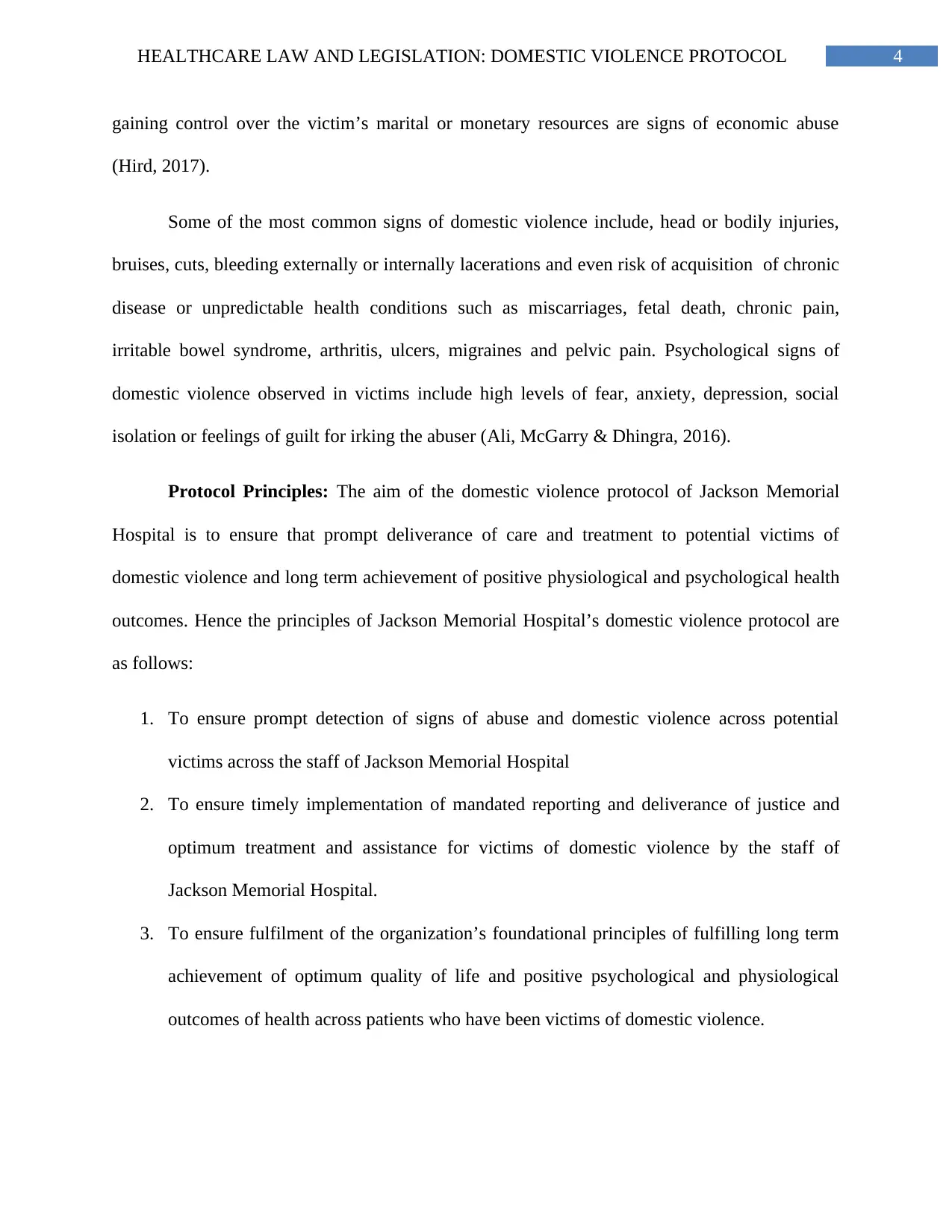
4HEALTHCARE LAW AND LEGISLATION: DOMESTIC VIOLENCE PROTOCOL
gaining control over the victim’s marital or monetary resources are signs of economic abuse
(Hird, 2017).
Some of the most common signs of domestic violence include, head or bodily injuries,
bruises, cuts, bleeding externally or internally lacerations and even risk of acquisition of chronic
disease or unpredictable health conditions such as miscarriages, fetal death, chronic pain,
irritable bowel syndrome, arthritis, ulcers, migraines and pelvic pain. Psychological signs of
domestic violence observed in victims include high levels of fear, anxiety, depression, social
isolation or feelings of guilt for irking the abuser (Ali, McGarry & Dhingra, 2016).
Protocol Principles: The aim of the domestic violence protocol of Jackson Memorial
Hospital is to ensure that prompt deliverance of care and treatment to potential victims of
domestic violence and long term achievement of positive physiological and psychological health
outcomes. Hence the principles of Jackson Memorial Hospital’s domestic violence protocol are
as follows:
1. To ensure prompt detection of signs of abuse and domestic violence across potential
victims across the staff of Jackson Memorial Hospital
2. To ensure timely implementation of mandated reporting and deliverance of justice and
optimum treatment and assistance for victims of domestic violence by the staff of
Jackson Memorial Hospital.
3. To ensure fulfilment of the organization’s foundational principles of fulfilling long term
achievement of optimum quality of life and positive psychological and physiological
outcomes of health across patients who have been victims of domestic violence.
gaining control over the victim’s marital or monetary resources are signs of economic abuse
(Hird, 2017).
Some of the most common signs of domestic violence include, head or bodily injuries,
bruises, cuts, bleeding externally or internally lacerations and even risk of acquisition of chronic
disease or unpredictable health conditions such as miscarriages, fetal death, chronic pain,
irritable bowel syndrome, arthritis, ulcers, migraines and pelvic pain. Psychological signs of
domestic violence observed in victims include high levels of fear, anxiety, depression, social
isolation or feelings of guilt for irking the abuser (Ali, McGarry & Dhingra, 2016).
Protocol Principles: The aim of the domestic violence protocol of Jackson Memorial
Hospital is to ensure that prompt deliverance of care and treatment to potential victims of
domestic violence and long term achievement of positive physiological and psychological health
outcomes. Hence the principles of Jackson Memorial Hospital’s domestic violence protocol are
as follows:
1. To ensure prompt detection of signs of abuse and domestic violence across potential
victims across the staff of Jackson Memorial Hospital
2. To ensure timely implementation of mandated reporting and deliverance of justice and
optimum treatment and assistance for victims of domestic violence by the staff of
Jackson Memorial Hospital.
3. To ensure fulfilment of the organization’s foundational principles of fulfilling long term
achievement of optimum quality of life and positive psychological and physiological
outcomes of health across patients who have been victims of domestic violence.
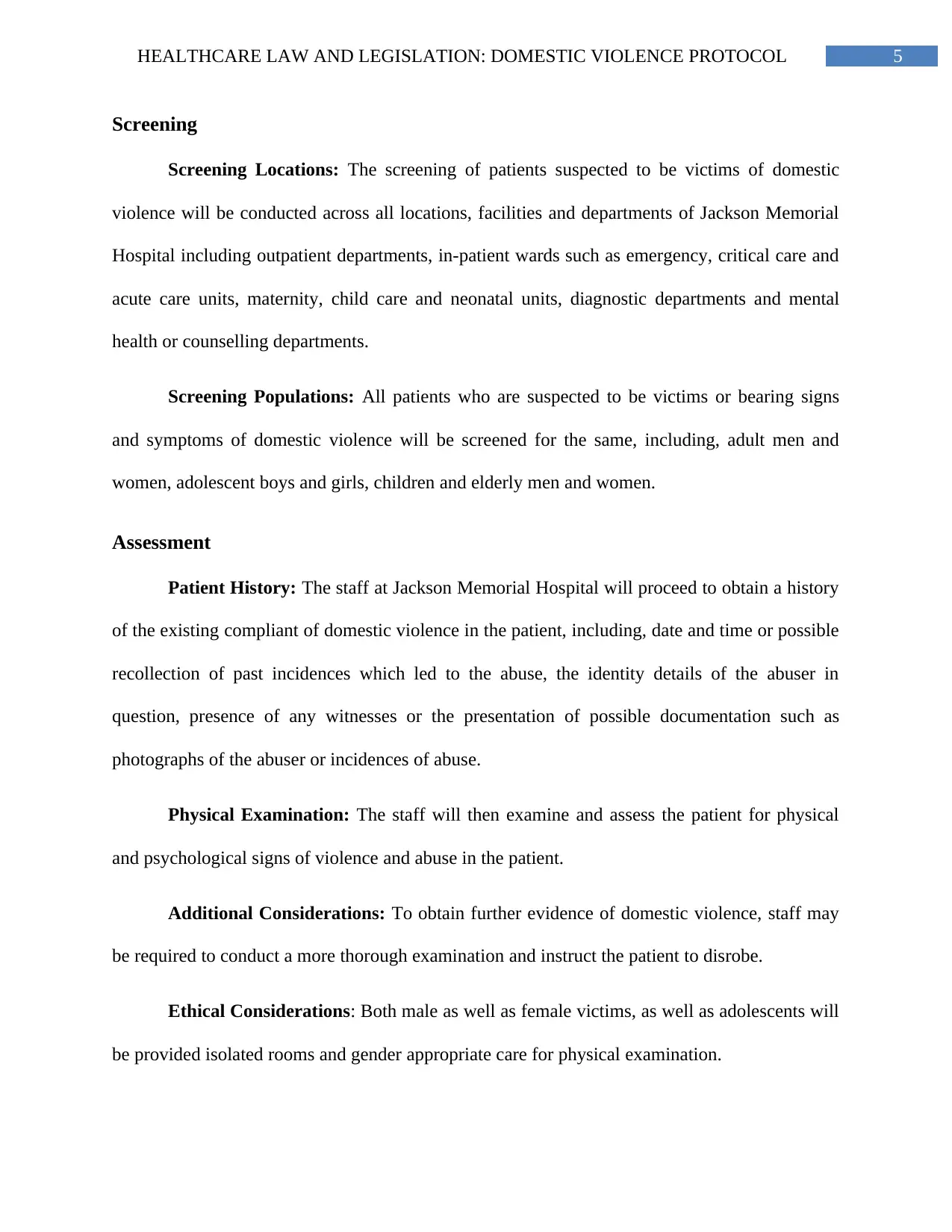
5HEALTHCARE LAW AND LEGISLATION: DOMESTIC VIOLENCE PROTOCOL
Screening
Screening Locations: The screening of patients suspected to be victims of domestic
violence will be conducted across all locations, facilities and departments of Jackson Memorial
Hospital including outpatient departments, in-patient wards such as emergency, critical care and
acute care units, maternity, child care and neonatal units, diagnostic departments and mental
health or counselling departments.
Screening Populations: All patients who are suspected to be victims or bearing signs
and symptoms of domestic violence will be screened for the same, including, adult men and
women, adolescent boys and girls, children and elderly men and women.
Assessment
Patient History: The staff at Jackson Memorial Hospital will proceed to obtain a history
of the existing compliant of domestic violence in the patient, including, date and time or possible
recollection of past incidences which led to the abuse, the identity details of the abuser in
question, presence of any witnesses or the presentation of possible documentation such as
photographs of the abuser or incidences of abuse.
Physical Examination: The staff will then examine and assess the patient for physical
and psychological signs of violence and abuse in the patient.
Additional Considerations: To obtain further evidence of domestic violence, staff may
be required to conduct a more thorough examination and instruct the patient to disrobe.
Ethical Considerations: Both male as well as female victims, as well as adolescents will
be provided isolated rooms and gender appropriate care for physical examination.
Screening
Screening Locations: The screening of patients suspected to be victims of domestic
violence will be conducted across all locations, facilities and departments of Jackson Memorial
Hospital including outpatient departments, in-patient wards such as emergency, critical care and
acute care units, maternity, child care and neonatal units, diagnostic departments and mental
health or counselling departments.
Screening Populations: All patients who are suspected to be victims or bearing signs
and symptoms of domestic violence will be screened for the same, including, adult men and
women, adolescent boys and girls, children and elderly men and women.
Assessment
Patient History: The staff at Jackson Memorial Hospital will proceed to obtain a history
of the existing compliant of domestic violence in the patient, including, date and time or possible
recollection of past incidences which led to the abuse, the identity details of the abuser in
question, presence of any witnesses or the presentation of possible documentation such as
photographs of the abuser or incidences of abuse.
Physical Examination: The staff will then examine and assess the patient for physical
and psychological signs of violence and abuse in the patient.
Additional Considerations: To obtain further evidence of domestic violence, staff may
be required to conduct a more thorough examination and instruct the patient to disrobe.
Ethical Considerations: Both male as well as female victims, as well as adolescents will
be provided isolated rooms and gender appropriate care for physical examination.
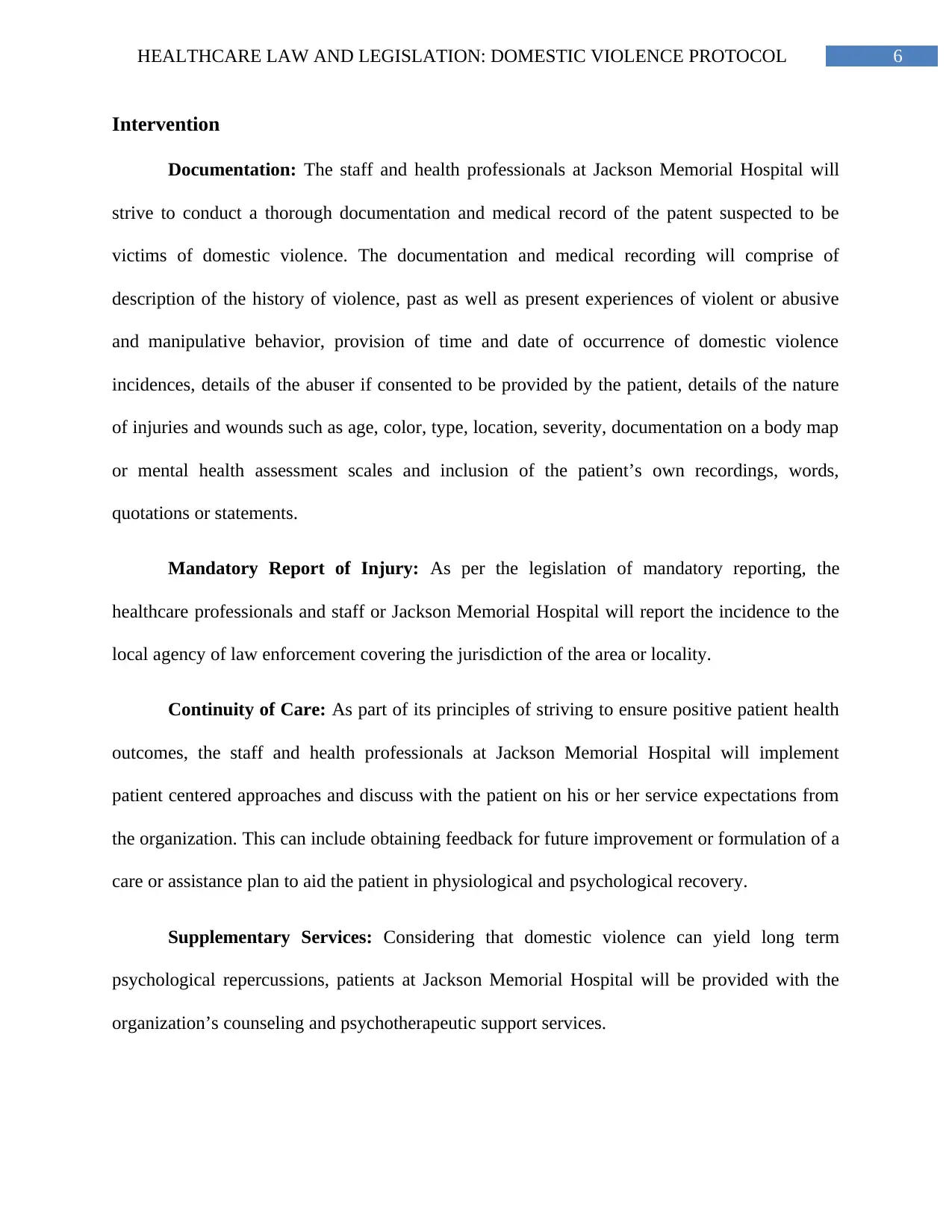
6HEALTHCARE LAW AND LEGISLATION: DOMESTIC VIOLENCE PROTOCOL
Intervention
Documentation: The staff and health professionals at Jackson Memorial Hospital will
strive to conduct a thorough documentation and medical record of the patent suspected to be
victims of domestic violence. The documentation and medical recording will comprise of
description of the history of violence, past as well as present experiences of violent or abusive
and manipulative behavior, provision of time and date of occurrence of domestic violence
incidences, details of the abuser if consented to be provided by the patient, details of the nature
of injuries and wounds such as age, color, type, location, severity, documentation on a body map
or mental health assessment scales and inclusion of the patient’s own recordings, words,
quotations or statements.
Mandatory Report of Injury: As per the legislation of mandatory reporting, the
healthcare professionals and staff or Jackson Memorial Hospital will report the incidence to the
local agency of law enforcement covering the jurisdiction of the area or locality.
Continuity of Care: As part of its principles of striving to ensure positive patient health
outcomes, the staff and health professionals at Jackson Memorial Hospital will implement
patient centered approaches and discuss with the patient on his or her service expectations from
the organization. This can include obtaining feedback for future improvement or formulation of a
care or assistance plan to aid the patient in physiological and psychological recovery.
Supplementary Services: Considering that domestic violence can yield long term
psychological repercussions, patients at Jackson Memorial Hospital will be provided with the
organization’s counseling and psychotherapeutic support services.
Intervention
Documentation: The staff and health professionals at Jackson Memorial Hospital will
strive to conduct a thorough documentation and medical record of the patent suspected to be
victims of domestic violence. The documentation and medical recording will comprise of
description of the history of violence, past as well as present experiences of violent or abusive
and manipulative behavior, provision of time and date of occurrence of domestic violence
incidences, details of the abuser if consented to be provided by the patient, details of the nature
of injuries and wounds such as age, color, type, location, severity, documentation on a body map
or mental health assessment scales and inclusion of the patient’s own recordings, words,
quotations or statements.
Mandatory Report of Injury: As per the legislation of mandatory reporting, the
healthcare professionals and staff or Jackson Memorial Hospital will report the incidence to the
local agency of law enforcement covering the jurisdiction of the area or locality.
Continuity of Care: As part of its principles of striving to ensure positive patient health
outcomes, the staff and health professionals at Jackson Memorial Hospital will implement
patient centered approaches and discuss with the patient on his or her service expectations from
the organization. This can include obtaining feedback for future improvement or formulation of a
care or assistance plan to aid the patient in physiological and psychological recovery.
Supplementary Services: Considering that domestic violence can yield long term
psychological repercussions, patients at Jackson Memorial Hospital will be provided with the
organization’s counseling and psychotherapeutic support services.
Paraphrase This Document
Need a fresh take? Get an instant paraphrase of this document with our AI Paraphraser
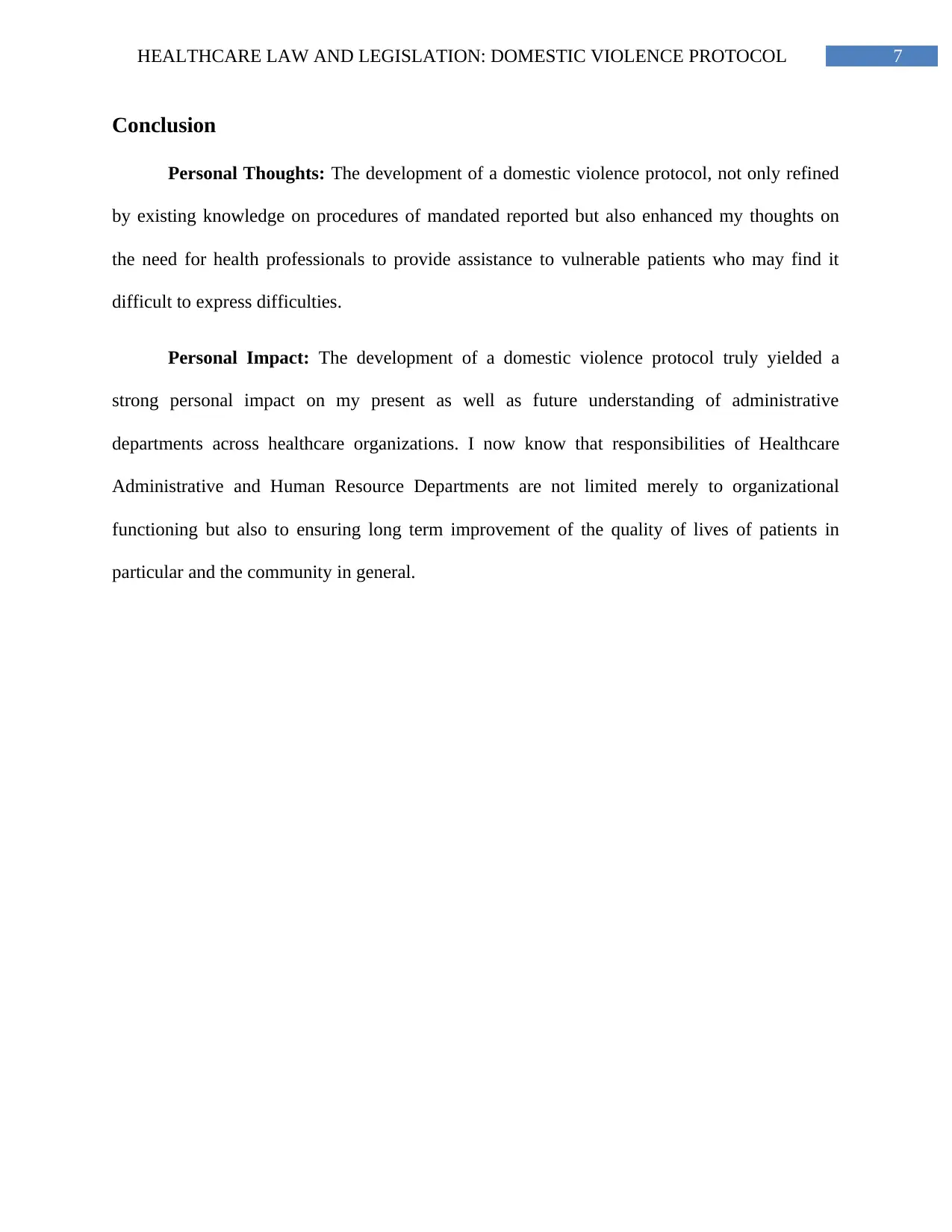
7HEALTHCARE LAW AND LEGISLATION: DOMESTIC VIOLENCE PROTOCOL
Conclusion
Personal Thoughts: The development of a domestic violence protocol, not only refined
by existing knowledge on procedures of mandated reported but also enhanced my thoughts on
the need for health professionals to provide assistance to vulnerable patients who may find it
difficult to express difficulties.
Personal Impact: The development of a domestic violence protocol truly yielded a
strong personal impact on my present as well as future understanding of administrative
departments across healthcare organizations. I now know that responsibilities of Healthcare
Administrative and Human Resource Departments are not limited merely to organizational
functioning but also to ensuring long term improvement of the quality of lives of patients in
particular and the community in general.
Conclusion
Personal Thoughts: The development of a domestic violence protocol, not only refined
by existing knowledge on procedures of mandated reported but also enhanced my thoughts on
the need for health professionals to provide assistance to vulnerable patients who may find it
difficult to express difficulties.
Personal Impact: The development of a domestic violence protocol truly yielded a
strong personal impact on my present as well as future understanding of administrative
departments across healthcare organizations. I now know that responsibilities of Healthcare
Administrative and Human Resource Departments are not limited merely to organizational
functioning but also to ensuring long term improvement of the quality of lives of patients in
particular and the community in general.
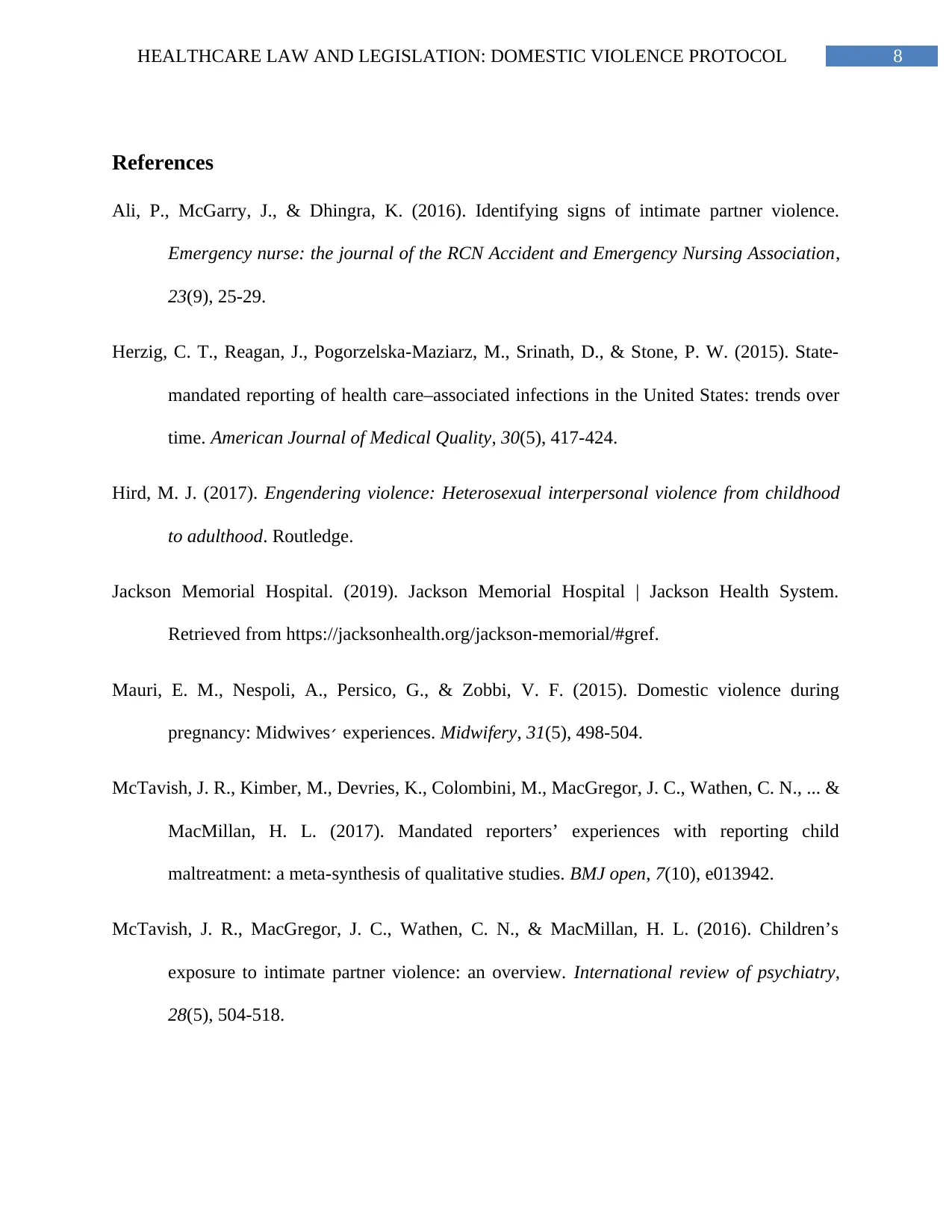
8HEALTHCARE LAW AND LEGISLATION: DOMESTIC VIOLENCE PROTOCOL
References
Ali, P., McGarry, J., & Dhingra, K. (2016). Identifying signs of intimate partner violence.
Emergency nurse: the journal of the RCN Accident and Emergency Nursing Association,
23(9), 25-29.
Herzig, C. T., Reagan, J., Pogorzelska-Maziarz, M., Srinath, D., & Stone, P. W. (2015). State-
mandated reporting of health care–associated infections in the United States: trends over
time. American Journal of Medical Quality, 30(5), 417-424.
Hird, M. J. (2017). Engendering violence: Heterosexual interpersonal violence from childhood
to adulthood. Routledge.
Jackson Memorial Hospital. (2019). Jackson Memorial Hospital | Jackson Health System.
Retrieved from https://jacksonhealth.org/jackson-memorial/#gref.
Mauri, E. M., Nespoli, A., Persico, G., & Zobbi, V. F. (2015). Domestic violence during
pregnancy: Midwives׳ experiences. Midwifery, 31(5), 498-504.
McTavish, J. R., Kimber, M., Devries, K., Colombini, M., MacGregor, J. C., Wathen, C. N., ... &
MacMillan, H. L. (2017). Mandated reporters’ experiences with reporting child
maltreatment: a meta-synthesis of qualitative studies. BMJ open, 7(10), e013942.
McTavish, J. R., MacGregor, J. C., Wathen, C. N., & MacMillan, H. L. (2016). Children’s
exposure to intimate partner violence: an overview. International review of psychiatry,
28(5), 504-518.
References
Ali, P., McGarry, J., & Dhingra, K. (2016). Identifying signs of intimate partner violence.
Emergency nurse: the journal of the RCN Accident and Emergency Nursing Association,
23(9), 25-29.
Herzig, C. T., Reagan, J., Pogorzelska-Maziarz, M., Srinath, D., & Stone, P. W. (2015). State-
mandated reporting of health care–associated infections in the United States: trends over
time. American Journal of Medical Quality, 30(5), 417-424.
Hird, M. J. (2017). Engendering violence: Heterosexual interpersonal violence from childhood
to adulthood. Routledge.
Jackson Memorial Hospital. (2019). Jackson Memorial Hospital | Jackson Health System.
Retrieved from https://jacksonhealth.org/jackson-memorial/#gref.
Mauri, E. M., Nespoli, A., Persico, G., & Zobbi, V. F. (2015). Domestic violence during
pregnancy: Midwives׳ experiences. Midwifery, 31(5), 498-504.
McTavish, J. R., Kimber, M., Devries, K., Colombini, M., MacGregor, J. C., Wathen, C. N., ... &
MacMillan, H. L. (2017). Mandated reporters’ experiences with reporting child
maltreatment: a meta-synthesis of qualitative studies. BMJ open, 7(10), e013942.
McTavish, J. R., MacGregor, J. C., Wathen, C. N., & MacMillan, H. L. (2016). Children’s
exposure to intimate partner violence: an overview. International review of psychiatry,
28(5), 504-518.
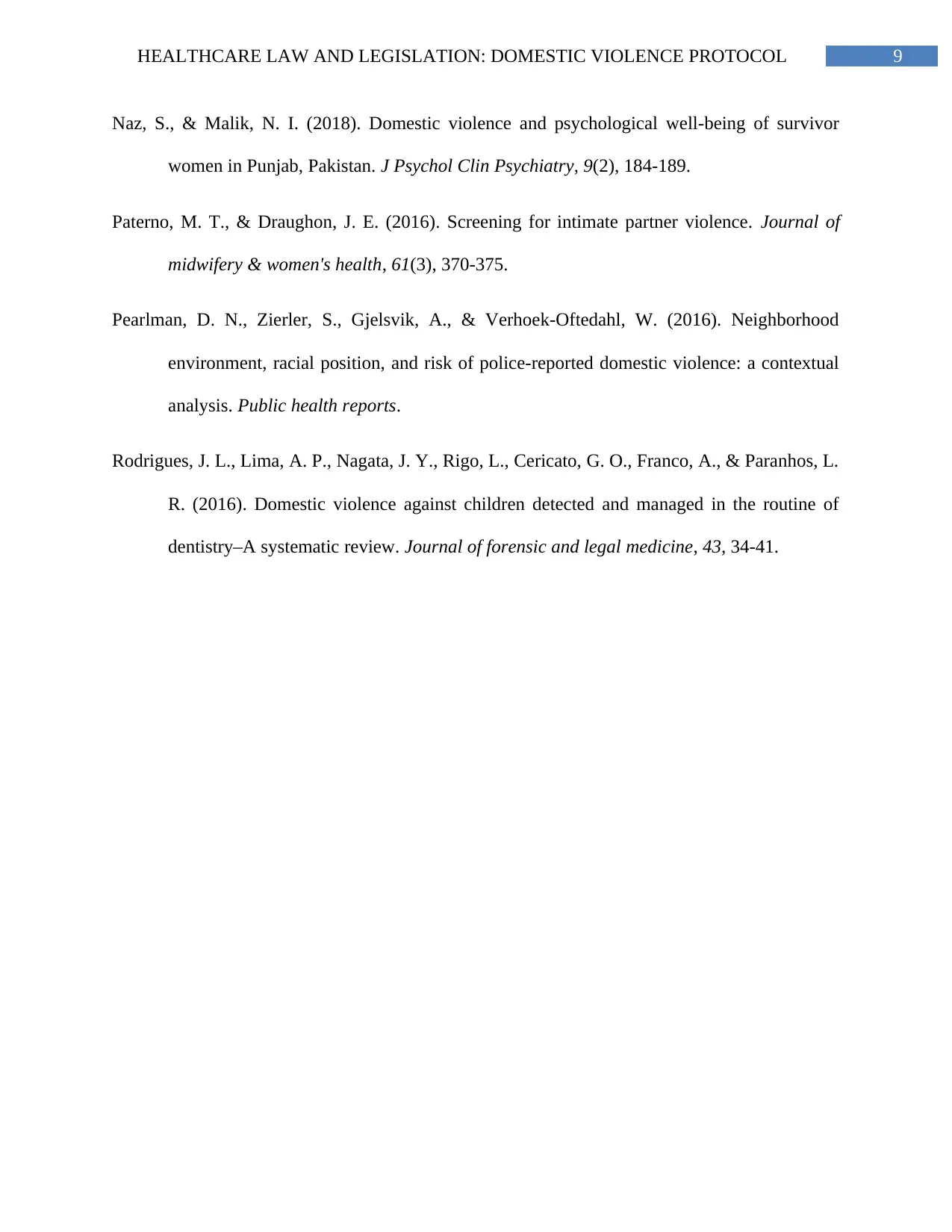
9HEALTHCARE LAW AND LEGISLATION: DOMESTIC VIOLENCE PROTOCOL
Naz, S., & Malik, N. I. (2018). Domestic violence and psychological well-being of survivor
women in Punjab, Pakistan. J Psychol Clin Psychiatry, 9(2), 184-189.
Paterno, M. T., & Draughon, J. E. (2016). Screening for intimate partner violence. Journal of
midwifery & women's health, 61(3), 370-375.
Pearlman, D. N., Zierler, S., Gjelsvik, A., & Verhoek-Oftedahl, W. (2016). Neighborhood
environment, racial position, and risk of police-reported domestic violence: a contextual
analysis. Public health reports.
Rodrigues, J. L., Lima, A. P., Nagata, J. Y., Rigo, L., Cericato, G. O., Franco, A., & Paranhos, L.
R. (2016). Domestic violence against children detected and managed in the routine of
dentistry–A systematic review. Journal of forensic and legal medicine, 43, 34-41.
Naz, S., & Malik, N. I. (2018). Domestic violence and psychological well-being of survivor
women in Punjab, Pakistan. J Psychol Clin Psychiatry, 9(2), 184-189.
Paterno, M. T., & Draughon, J. E. (2016). Screening for intimate partner violence. Journal of
midwifery & women's health, 61(3), 370-375.
Pearlman, D. N., Zierler, S., Gjelsvik, A., & Verhoek-Oftedahl, W. (2016). Neighborhood
environment, racial position, and risk of police-reported domestic violence: a contextual
analysis. Public health reports.
Rodrigues, J. L., Lima, A. P., Nagata, J. Y., Rigo, L., Cericato, G. O., Franco, A., & Paranhos, L.
R. (2016). Domestic violence against children detected and managed in the routine of
dentistry–A systematic review. Journal of forensic and legal medicine, 43, 34-41.
1 out of 10
Your All-in-One AI-Powered Toolkit for Academic Success.
+13062052269
info@desklib.com
Available 24*7 on WhatsApp / Email
![[object Object]](/_next/static/media/star-bottom.7253800d.svg)
Unlock your academic potential
© 2024 | Zucol Services PVT LTD | All rights reserved.